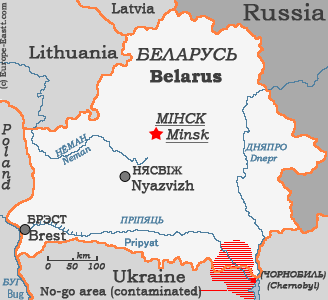Official name
РЭСПУБЛІКА БЕЛАРУСЬ (Respublika Belarus') = Republic of Belarus. Another quite common name is White Russia, although this name is slightly confusing. The word "-rus" does not derive from the word "Russia" but from the ancient (Kievan) Rus, which also gave Russia its present name. The word 'Bela-' (resp. belo-) means 'white' in many Slavic languages. However, hundreds of years ago the same word had many more meanings, such as 'pure', 'free', 'western' but also 'northern'. There was also a historic region called 'Black Russia'. To cut a long story short - 'belo' might have nothing to do with the colour. Historically, the name White Ruthenia was widely used, too. Nowadays, the most common name is Belarus.
Area & Population

| ||
| Clickable map of the Belarus |
The Belarus covers 207,600 km² - roughly the same size as Kansas. "Thanks" to the 2nd World War, present-day Belarus is much bigger than it was 100 years ago.
The country is home to around 10.3 million* people (2004). Compared to other European countries, Belarus is rather sparsely populated. And the trend is negative - the growth rate is far below zero.
Around 81% are Belarusians, some 11% Russians. Other minorities (sorted by their share) include Ukrainians, Germans, Poles, Jews, Latvians etc. Before World War II, there was a very strong Jewish community in the country.*
Religion
Religion: Around 80% are Orthodox, but there is also a strong Roman-Catholic minority as well as Protestants and Jews*.
Time zone
GMT +02 hrs (one hour behind Russia, 1 hr before Central Europe), with daylight-saving time (+1 hour) in summer.
Belarusian is the official language, but in 1995 Russian was appointed to be the second official language. As a matter of fact, Russian is gradually pushing back the Belarusian language. Belarusian is very close to the Russian language, but it has some distinctive features, e.g. a large number of Polish loanwords. Partially, Belarusian shows strong similarities with →Ukrainian, which is the closest language to Belarusian. Belarusian uses the Cyrillic alphabet, but there are some differences to the alphabet used in Russian. Differences in writing and pronunciation include:
- A (a): Every 'A'- sound (as in large) is written with an 'A', which is different to Russian (see 'o').
- Г (г) - In Russian, this letter as a 'G' as in 'gap'. In Belarusian, it's a fricative sound close to the 'ch' in the Scottish word 'loch'. Which means, that for example the town Гродна is not pronounced 'Grodna' but Hrodna.
- Ґ (ґ) Not being used now, but this letter might be re-introduced in the near future. Pronounced as "ch" (see the letter above).
- Ë (ë) is pronounced 'YO'. In Russia, the letter is often substituted by a simple 'E' (although the pronunciation is the same). In Belarusian, this letter is consequently used.
- I (i) substitutes the Russian И (и). Always read as a simple 'i', shorter than the 'ee' in 'need'.
- O (o) is very often read as an 'A' in Russian. In Belarusian, every 'O' that is pronounced as an 'A' , is written as an 'A'. Belarusian writing is more consequent so to say. Anyway, for people being familiar with Russian, Belarusian might look a little bit funny in the beginning.
- Ў (ў) Transliterated as Ů (ŭ) and pronounced as a 'U', although it's actually a semivowel. Not used in most other Cyrillic scripts and therefore unique.
- Щ (щ) (shtsh) - is not used in Belarusian.
- Ъ (ъ) (hard sign) - also not used in Belarusian.
- Э (э) is pronounced 'e' as in 'get' and much more often used than in Russian.
Despite numerous dialects it's fairly easy to get around with Russian. Most print media and tv channels use Russian, too. Don't expect to meet many people being able to speak English. Compared to other countries in Europe, English is not very useful, and due to the lack of foreigners most people expect you to be fluent in Russian. Travelers who don't understand any Russian or Ukrainian may find it difficult to communicate. Not surprisingly, registration forms etc. are exclusively in Russian.
I have tried to use the Belarusian place names in these pages as often as possible. However, in some cases I couldn't find out the Belarusian name, so I used the Russian name. Note that almost all city maps and other maps in Belarus are written in Russian, but the difference between Russian and Belarusian place names is rather small (often it's only about the different 'i' and a/o, see above).
©2024 Europe-East.com

 Albania
Albania Belarus
Belarus